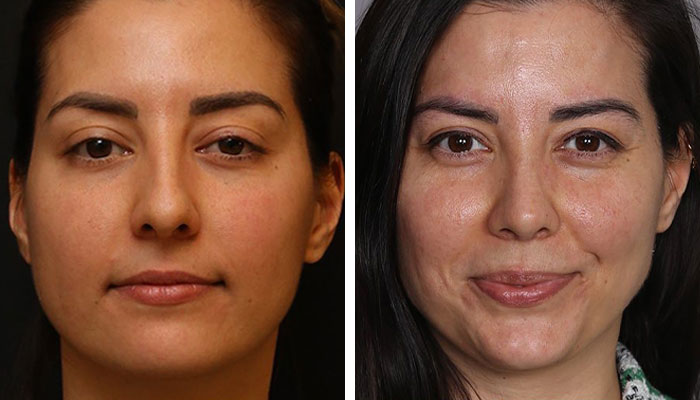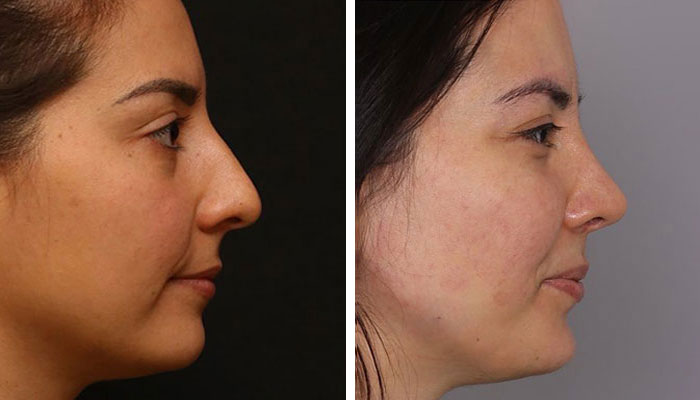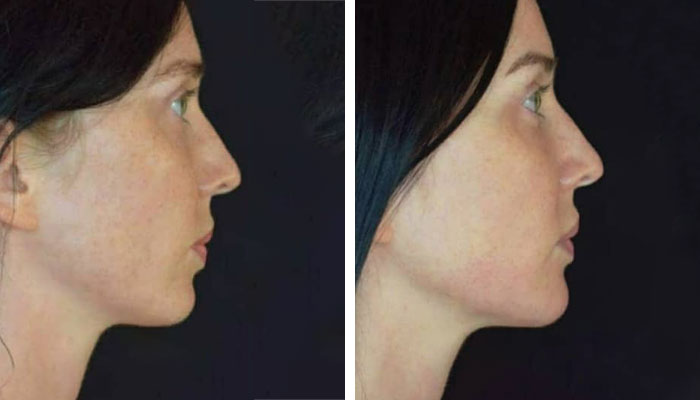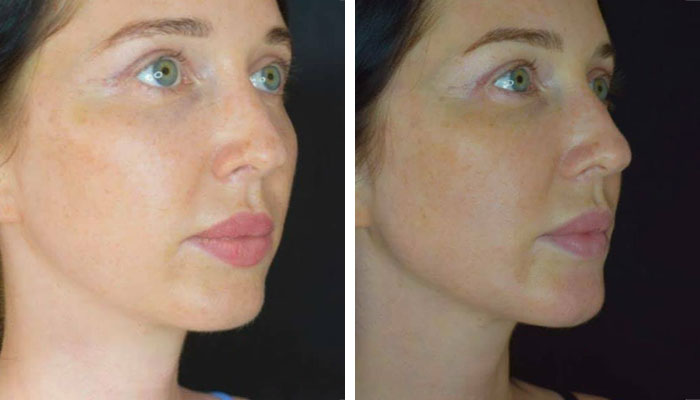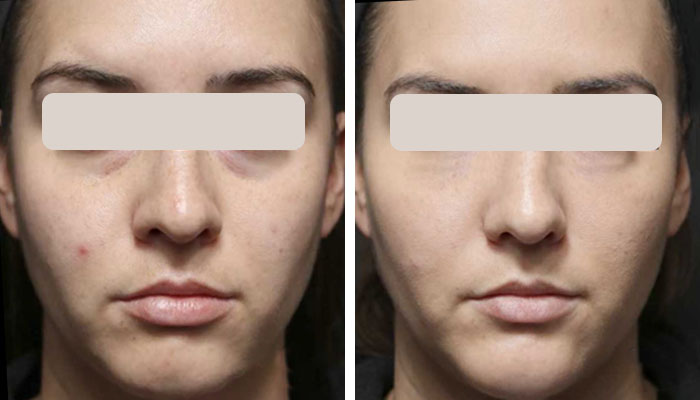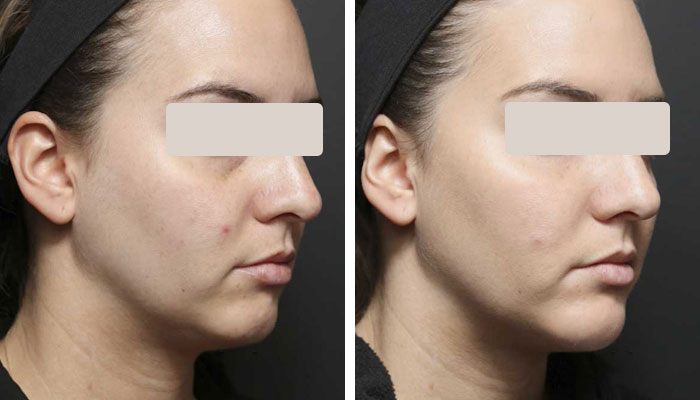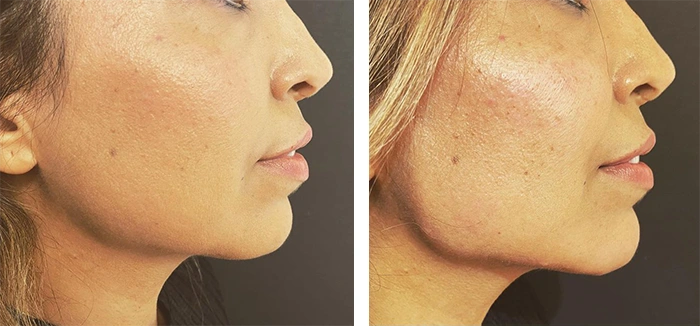What are chin and jawline fillers?
Chin and jawline fillers are cosmetic procedures that involve the use of injectable dermal fillers to enhance and reshape the chin and jawline areas. Dermal fillers typically consist of substances like hyaluronic acid or calcium hydroxyapatite, which are injected into specific areas to add volume, definition, and contour to the chin and jawline.
Chin fillers are used to augment a weak or recessed chin, creating a more balanced and harmonious facial profile. This procedure can help improve the appearance of a "double chin" or a weak jawline. The filler is injected along the chin bone or in the soft tissue to add volume and projection.
Jawline fillers, on the other hand, are used to enhance and define the jawline, giving it a more sculpted and chiseled appearance. This procedure can help create a more angular jawline or address the effects of aging, such as sagging jowls or loss of definition. The filler is injected along the jawline to add volume and contour.
It's important to note that chin and jawline fillers are temporary solutions, as the body gradually absorbs the filler material over time. The duration of the results can vary depending on the type of filler used, individual metabolism, and lifestyle factors. Maintenance treatments are typically required to sustain the desired outcome.
Why do people get chin filler or jawline filler?
People seek chin and jawline fillers for various reasons, including cosmetic enhancement and addressing specific concerns related to the appearance of their facial features. Here are some common reasons why individuals opt for chin or jawline fillers:
- Chin augmentation: Some people have a naturally weak or recessed chin, which can affect the overall balance and harmony of their facial features. Chin fillers can be used to add volume and projection to create a stronger and more defined chin, improving facial symmetry.
- Jawline definition: A well-defined jawline is often associated with youthfulness and attractiveness. Jawline fillers can enhance and sculpt the jawline, adding volume and contour to create a more angular and chiseled appearance. This can help individuals achieve a more harmonious facial profile.
- Correcting facial imbalances: Chin and jawline fillers can help correct facial imbalances caused by genetics or aging. For example, individuals with a receding chin or weak jawline may choose fillers to restore balance and improve the overall appearance of their face.
- Addressing signs of aging: As we age, the skin loses elasticity and volume, leading to a loss of definition and sagging in the chin and jawline area. Fillers can help address these concerns by restoring volume, lifting sagging skin, and rejuvenating the overall appearance of the lower face.
- Non-surgical alternative to surgery: Chin and jawline fillers offer a non-surgical alternative to more invasive procedures such as chin implants or jawline surgery. Fillers can provide noticeable results with minimal downtime and fewer risks compared to surgical options.
It's important to note that everyone's motivations and goals for seeking chin and jawline fillers may vary. It is essential to have a thorough consultation with a qualified medical professional to discuss your specific concerns and expectations and determine if fillers are the right option for you.
Who are good candidates for chin and jaw fillers?
Good candidates for chin and jawline fillers are individuals who have specific concerns or desires related to the appearance of their chin and jawline. Here are some factors that may make someone a suitable candidate for chin and jawline fillers:
- Weak or recessed chin: Individuals with a weak or recessed chin who desire more definition and projection may benefit from chin fillers. Fillers can add volume to the chin area, creating a more balanced and proportionate facial profile.
- Lack of jawline definition: Those who have a less defined or "soft" jawline may consider jawline fillers to add structure and contour. Fillers can help create a more sculpted and chiseled jawline, enhancing the overall facial aesthetics.
- Aging-related concerns: Individuals experiencing signs of aging in the chin and jawline area, such as sagging skin, loss of volume, or jowls, may find chin and jawline fillers helpful. Fillers can restore volume, lift sagging skin, and provide a rejuvenated appearance.
- Facial imbalances: People with facial imbalances, such as a disproportionate chin or jawline, may benefit from fillers to create a more harmonious and balanced facial profile.
- Non-surgical preference: Candidates who prefer non-surgical procedures and want to avoid the risks and recovery associated with surgery may find chin and jawline fillers appealing. Fillers offer noticeable results with minimal downtime.
It's important for candidates to have realistic expectations and understand that fillers provide temporary results. They should also be in good overall health and have no contraindications to the procedure. A consultation with a qualified medical professional, such as a dermatologist or plastic surgeon, is essential to assess candidacy, discuss goals, and address any concerns or questions before proceeding with chin and jawline fillers.
How is the chin and jawline filler procedure performed?
The chin and jawline filler procedure is typically performed by a qualified medical professional, such as a dermatologist or plastic surgeon. Here's a general overview of how the procedure is typically carried out:
- Consultation: The process begins with a consultation where you discuss your goals, concerns, and desired outcomes with your medical professional. They will assess your facial anatomy, evaluate your suitability for the procedure, and determine the most appropriate approach for your specific needs.
- Preparing for the procedure: Before the procedure, the treatment area will be cleaned, and a topical numbing cream or local anesthesia may be applied to minimize any discomfort during the injections.
- Injection technique: The medical professional will use a fine needle or a blunt-tipped cannula to inject the filler into specific areas of the chin and jawline. The injection technique may vary based on your individual needs and goals.
- Volume and contouring: The filler will be strategically injected to add volume, definition, and contour to the chin and jawline areas. The medical professional will carefully sculpt and shape the filler to achieve the desired outcome.
- Assessment and adjustments: Throughout the procedure, the medical professional will assess the results and make any necessary adjustments to ensure symmetry and balance. They may ask for your feedback and input during this process.
- Post-treatment care: Once the injections are complete, any necessary aftercare instructions will be provided. You may be advised to avoid touching or applying pressure to the treated area for a few hours and to avoid strenuous exercise or excessive heat for a day or two.
The procedure typically takes around 30 minutes to an hour, depending on the extent of the treatment. Results are generally immediate, although some swelling, redness, or bruising may occur initially. These temporary side effects usually subside within a few days.
What is the preparation like?
To prepare for a jaw and chin filler procedure, follow these general guidelines:
- Consultation: Schedule a consultation with a qualified medical professional to discuss your goals, expectations, medical history, and any concerns you may have. This will help determine if you are a suitable candidate for the procedure.
- Medical history: Provide a comprehensive medical history, including any allergies, previous cosmetic procedures, medications, or medical conditions. Disclose all relevant information to ensure your safety and minimize the risk of complications.
- Avoid blood thinners: Prior to the procedure, avoid blood-thinning medications or supplements like aspirin, ibuprofen, or fish oil, as they can increase the risk of bruising and bleeding. Follow your healthcare provider's instructions regarding the use of any medications.
- Hydration: Stay well-hydrated in the days leading up to the procedure. Proper hydration can help optimize the results and reduce the risk of complications.
- Avoid alcohol and caffeine: Limit alcohol and caffeine consumption for a few days before the procedure, as they can dehydrate the body and affect the healing process.
- Follow pre-procedure instructions: Your medical professional will provide specific instructions to follow before the procedure. This may include avoiding certain foods, skincare products, or activities that can increase the risk of infection or interfere with the procedure.
- Arrange transportation: If you are receiving sedation during the procedure, arrange for someone to drive you home afterward, as you may be temporarily impaired.
- Plan for recovery: Depending on the individual, there may be mild swelling or bruising after the procedure. Plan for some downtime and consider avoiding social events or strenuous activities for a few days.
Always follow the instructions provided by your medical professional, as they may have specific guidelines tailored to your situation. By preparing adequately, you can help ensure a smooth and successful jaw and chin filler procedure.
What to expect after the procedure?
After undergoing a jawline and chin filler procedure, there are several things you can expect during the post-treatment phase. Here's an overview of what to expect:
- Immediate results: You will notice immediate results after the procedure. Your chin and jawline will appear more defined, contoured, and enhanced. However, it's important to keep in mind that initial swelling or bruising may temporarily affect the final appearance.
- Swelling and bruising: It is common to experience some degree of swelling, redness, and bruising in the treated area. These side effects are usually mild and temporary, resolving within a few days or up to a week. Applying ice packs or cold compresses to the area can help reduce swelling.
- Discomfort: You may experience mild discomfort or tenderness at the injection sites. This is normal and typically resolves within a few days. Over-the-counter pain relievers can be taken as recommended by your medical professional to alleviate any discomfort.
- Avoiding certain activities: Your medical professional may advise you to avoid certain activities immediately after the procedure. This may include avoiding strenuous exercise, excessive heat or sun exposure, and facial massages for a few days. Following these instructions will help optimize the healing process.
- Final results: The full and final results of the jawline and chin filler procedure will become more apparent as any initial swelling subsides. It may take a few days or up to two weeks to see the complete outcome.
- Duration of results: The duration of results can vary depending on factors such as the type of filler used and individual metabolism. Generally, chin and jawline fillers last from several months to over a year. Maintenance treatments may be required to sustain the desired results.
- Follow-up appointment: Your medical professional may schedule a follow-up appointment to assess the results and address any concerns or questions you may have. This is an opportunity to discuss your satisfaction with the outcome and determine if any additional treatments or touch-ups are needed.
It's important to communicate with your medical professional throughout the post-treatment phase. If you have any unusual or concerning symptoms, such as severe pain, persistent swelling, or signs of infection, it's crucial to contact your medical professional promptly.
Remember that everyone's healing process may vary, and individual experiences may differ. By following post-treatment care instructions and staying in touch with your medical professional, you can optimize your recovery and enjoy the best possible outcome from your jawline and chin filler procedure.
What are the potential risks and complications of chin and jaw fillers?
While chin and jaw fillers are generally considered safe procedures, there are potential risks and complications that you should be aware of. It's important to discuss these risks with a qualified medical professional before undergoing the procedure. Here are some potential risks and complications associated with chin and jaw fillers:
- Bruising and swelling: Bruising and swelling are common side effects after the procedure. While they are usually mild and temporary, there is a possibility of more significant bruising or prolonged swelling in some cases.
- Infection: Although rare, there is a small risk of infection at the injection sites. It's important to ensure that proper sterile techniques are followed during the procedure to minimize this risk.
- Allergic reactions: While uncommon, allergic reactions to dermal fillers can occur. It's crucial to inform your medical professional of any known allergies or previous adverse reactions to minimize this risk.
- Asymmetry: There is a possibility of slight asymmetry in the results. Skillful injection techniques can help minimize this risk, but it's important to have realistic expectations and understand that perfect symmetry may not always be achievable.
- Nodules or lumps: Rarely, small nodules or lumps may develop at the injection sites. These can usually be massaged or dissolved by your medical professional if they occur.
- Vascular complications: In very rare cases, filler injections can inadvertently damage blood vessels, leading to complications such as skin necrosis (tissue death) or vision changes. However, these risks can be significantly reduced when performed by experienced medical professionals who have a thorough understanding of facial anatomy.
- Migration or displacement: Fillers can potentially migrate or become displaced from the intended treatment area. This can affect the desired results and may require additional treatments or adjustments.
- Granulomas: Granulomas are small, firm bumps that can form in response to filler material. While rare, they may require further treatment, such as steroid injections or surgical removal.
It's important to choose a qualified medical professional who has experience in performing chin and jawline filler procedures to minimize the risks. They can provide you with a thorough assessment, discuss the potential risks and benefits, and guide you through the decision-making process.
Remember to disclose your medical history, including any allergies, medications, or previous cosmetic procedures, to ensure your safety and minimize the risk of complications. By following pre- and post-treatment instructions and maintaining open communication with your medical professional, you can help mitigate potential risks and achieve a successful outcome.
What is the cost of a jaw and chin filler procedure?
The cost of a jaw and chin filler procedure can vary depending on several factors, including the geographic location, the experience and reputation of the medical professional, the type and quantity of filler used, and any additional fees associated with the clinic or facility. It's important to note that the cost can also vary based on the individual's specific needs and goals.
As a general guideline, the cost of jaw and chin filler procedures can range from around $500 to $2,500 per session. However, this is just an estimate, and the actual cost may be higher or lower depending on the factors mentioned above.
It's essential to consult with a qualified medical professional who can provide you with an accurate cost estimate based on your individual case. During the consultation, they will assess your specific needs, discuss the treatment plan, and provide you with a detailed breakdown of the costs involved.
Keep in mind that the cost of the procedure should not be the sole determining factor when choosing a medical professional. It's important to prioritize the qualifications, experience, and reputation of the practitioner to ensure your safety and achieve the desired results.
What are other alternatives to chin and jawline fillers?
In addition to chin and jawline fillers, there are several alternative options available for enhancing the chin and jawline. These alternatives vary in terms of invasiveness, permanence, and the results they can achieve. Here are a few alternatives to consider:
- Chin/jawline implants: Similar to chin implants, jawline implants can be surgically placed to enhance the shape and definition of the chin and jawline. Implants are typically made of silicone or other biocompatible materials. This surgical option provides a permanent solution and can create more significant changes to the bone structure.
- Fat transfer: Fat transfer, also known as fat grafting, involves harvesting fat from one area of the body (usually through liposuction) and injecting it into the chin or jawline to add volume and contour. This procedure is minimally invasive and can provide natural-looking results. However, it may require multiple sessions and has the limitation of fat absorption over time.
- Orthognathic surgery: In cases where there are significant structural issues affecting the chin and jawline, orthognathic surgery may be considered. This surgical procedure involves repositioning the jawbones to correct bite alignment and improve facial harmony. It can provide substantial changes to the chin and jawline, but it is a more invasive option that requires careful consideration and planning.
- Thread lift: A thread lift is a non-surgical procedure that uses dissolvable sutures with tiny cones to lift and tighten the skin. It can be performed to improve the definition and contour of the chin and jawline. Thread lifts provide immediate results with minimal downtime, although the effects are temporary and can last for several months.
- Ultrasound or radiofrequency-based treatments: Procedures such as Ultherapy and radiofrequency-based treatments like Thermage use targeted energy to stimulate collagen production and tighten the skin. These non-invasive treatments can help improve the appearance of the chin and jawline by providing a subtle lifting effect. Results are gradual and may require multiple sessions for optimal outcomes.
- Makeup contouring: Makeup techniques can be used to create the illusion of a more defined chin and jawline. By using shading and highlighting techniques, you can enhance the contours and create the appearance of sharper features. This is a non-invasive and temporary option that can be easily modified as desired.
Chin/jaw fillers vs. chin/jaw implants: pros and cons
Chin/jaw fillers and chin/jaw implants are both popular options for enhancing the appearance of the chin and jawline. Each option has its own set of pros and cons. Here's a comparison:
Chin and jaw fillers pros
- Non-surgical: Fillers are minimally invasive and do not require surgery. The procedure can be performed in an outpatient setting, usually with minimal downtime and recovery.
- Immediate results: Fillers provide instant results, and the outcome is visible immediately after the procedure.
- Reversible: Unlike implants, fillers are temporary and can be reversed if desired. The effects typically last several months to over a year, depending on the type of filler used.
- Less risk: Fillers generally carry fewer risks and complications compared to surgery. Vascular complications and infection risks are relatively low.
Chin and jaw fillers cons
- Temporary results: The effects of fillers are not permanent and require maintenance treatments to sustain the desired results.
- Limited volume enhancement: Fillers can add volume and definition to the chin and jawline, but their ability to significantly change the underlying bone structure is limited.
- Repeat treatments: To maintain the desired results, repeat treatments are necessary as the filler gradually gets absorbed by the body.
Chin and jaw implants pros
- Permanent results: Implants provide a permanent solution for enhancing the chin and jawline. Once the implant is placed, the results are long-lasting.
- Structural changes: Implants can create more significant changes to the bone structure, providing a more pronounced and defined chin and jawline.
- Customizable: Implants come in various shapes and sizes, allowing for customization to achieve the desired aesthetic outcome.
Chin and jaw implants cons
- Surgical procedure: Chin/jaw implants require surgery, which involves anesthesia, incisions, and a recovery period. It carries the inherent risks associated with any surgical procedure.
- Longer recovery: Compared to fillers, the recovery period for implant surgery is longer. Swelling, bruising, and discomfort may last for several weeks.
- Irreversible: Unlike fillers, chin/jaw implants are permanent and cannot be easily reversed or adjusted once placed.
- Higher risk: Implant surgery carries higher risks such as infection, implant shifting, and potential damage to nerves or surrounding structures.
The choice between chin/jaw fillers and chin/jaw implants depends on factors such as your desired outcome, preference for temporary or permanent results, willingness to undergo surgery, and the advice of a qualified medical professional. It's important to have a thorough consultation with a reputable practitioner to discuss your goals, assess your suitability, and make an informed decision.
FAQs
How long do results from jaw or chin fillers last?
The duration of results from jaw or chin fillers typically lasts several months to over a year, depending on the type of filler used and individual factors.
Is the chin and jawline filler procedure painful?
The chin and jawline filler procedure may cause some discomfort. However, a topical anesthetic or numbing agent is often applied to minimize pain. Additionally, some fillers contain lidocaine, a local anesthetic, to enhance comfort during the procedure.

